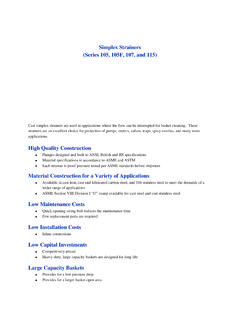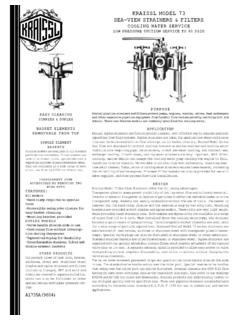Transcription of FCI STANDARD #89-1 Guide for the selection, …
1 1 FCI STANDARD #89-1 Guide for the selection, Installation and Maintenanceof Pipe Line StrainersPrepared byPINE LINE STRAINER SECTIONFLUID CONTROLS INSTITUTE, - Pipe Line strainers - Definition, Purposes and Types2 - End Connections3 - Materials of Construction4 - Corrosion Resistance - Selection of Materials5 - Perforations and Mesh Sizing6 - Capacity7 - Pressure Loss8 - Specifications and Manufacturer Testng9 - Shock - Hydraulic and Thermal10 - ConclusionPREFACEE xperience has proven the need for strainers in the protection of pumps, compressors, turbines, meters, automatic valves, sprinkler heads, burner nozzles, steam traps and other pipeline equipment.
2 This Guide has been established as a technical reference for project engineers and managers responsible for specifying and using pipeline strainers . While strainers remain a relatively low cost item, when specified, properly, the protection they provide is invaluable. It is the intent of this Guide to provide the background and information necessary to make knowledgeable and sound engineering decisions in the specification of pipeline strainers . The Pipe Line Strainer Section of the Fluid Controls Institute Inc acknowledges and appreciates the assistance of those people who have made the creation and updating of this technical resource Metraflex Company2323 W.
3 Hubbard St. Chicago, IL 60612 1-800-621-4347 312-738-3800 Fax 312-738-0415 1 DefinitionA pipe line strainer is a device which provides a means of mechanically removing solids form a flowing fluid by utilizing a perforated, mesh or wedge wire straining element. The most common range of strainer particle retention is 1 inch to 40 micron (.00156 inch ).PurposeStrainers are employed in pipe lines to protect downstream mechanical equipment such as condensers, heat exchanges, pumps, compressor, meters, spray nozzles, turbines, steam traps, etc. from the detrimental effect of sediment, rust, pipe scale or other extraneous of StrainersTwo frequently specified strainer are the Y strainer and the basket strainer.
4 While there is primarily one type of Y strainer (Fig. 1A), there are several variations of basket strainers . (Fig 1B through 1E). Vertical piping, frequently found at pump inlets, necessitates the use of a Y strainer or a tee and the drain (blowdown) connection in their lowest position. (Fig. 2). A Y strainer in vertical piping must be placed with its screen in the downward position to trap the sediment in the debris collection chamber. Tee type strainers , suction diffusers and several variations of fabricated basket strainers can also be used in a right angle flow application. (Fig. 3).
5 Y strainers and most variations of basket strainers can be self-cleaning. With the addition of a blowdown valve and some modification of the straining element of a basket strainer, the element can be flushed out by opening and closing the blowdown valve. This can be done without flow shut down or disassembling any sizes above 4 , a single basket strainer will generally create less pressure drop than a Y type. basket strainers are normally installed in a horizontal pipe with the cover over the basket at the top. Cleaning of the strainer generally simple and no draining is required. Cover flanges for basket strainers are relatively easy to remove and servicing is simplified.
6 Replacement of covers on Y -type strainers is facilitated by some manufacturers through the use of studs, rather than bolts, which help to align the cover during the replacement operation. Hinged covers and screen licking devices can also make servicing seems to be a general misconception among engineers and contractors concerning Y strainers and basket strainers used in steam service. In many instances, basket and Y strainers will perform comparably in steam service. It is essential in ordering strainers for steam service that the manufacturer be so advised. As mentioned above, the housings may be furnished without a bottom, allowing the accumulate debris to blown out by opening the blowdown valve.
7 (Fig. 4).type basket strainer. Most basket strainers are intended for horizontal or slightly inclined piping. Y strainers and tee type basket strainers , on the other hand, can be used in horizontal as well as vertical (downward) piping. Special attention must be given, however, to maintaining the position of the debris collection chamber Fig. 1 AFig. 1 DFig. 1 EFig. 1 BFig. 1 CFig. 2 Fig. 3 Fig. 43 While there are some high pressure applications for basket strainers , (Fig. 5), due to the required thickness and subsequent high cost, basket strainers are not normally constructed for pressures above 1,500 psi.
8 Y strainers , on the other hand, are readily available for working pressures up to 6,000 psi and higher. In addition to Y and basket types, other strainers are available such as duplex/twin, geometric, washdown/backflushing, automatic self cleaning, plate or expanded cross section type, scraper, and magnetic screen types. Descriptions of these as well as miscellaneous options available with them, StrainersFor applications where continuous operation is required and the line cannot be disassembled for cleanout, duplex or twin basket strainers can be used. Refer also to Automatic strainers , Page 5, for continuous service applications .
9 Examples are fuel oil strainers for industrial or marine oil burners, lubricating lines on board ships, cooling towers, continuously running chemical operations, and many industrial water intake and service one basket becomes full, the flow is switched to the other basket . The first basket is removed, cleaned and replaced. For smaller sizes the plug - type duplex basket strainer (Fig. 6) is generally used since it is less costly to make and simpler to operate and maintain than other types. It is basically a plug valve with two integral basket wells into which flow can be diverted by rotating the plug.
10 In larger sizes the plug design becomes unwieldy, and an individual valving arrangement is used (Fig. 7). Here, flow is shifted from one basket to the other by integral sliding gate valves. These strainers are frequently furnished with an interlocking chain-drive mechanism so the two valves work in unison (one basket compartment opens while the other is being valved off). This prevents accidental shutoff of the type strainer can be furnished with individual globe valves instead of gate valves. Globe valves give more positive shutoff, but since these strainers are not normally used for high pressures they are generally not needed.








